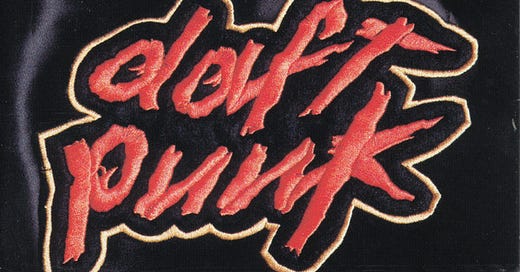This week we have a guest appearance from Friend of The Hole, Cameron, who is a Wellington-based DJ and lover of all things that go doof. Cameron will be discussing a classic house record that anyone interested in electronic music should definitely listen to.
Daft Punk’s debut album Homework is renowned for introducing the hypnotic repetition and punchy bass lines of French house to the world. Before we heard nostalgic hits like Stardust’s The Music Sounds Better With You and Modjo’s Lady, the path forward was carved by Thomas Bangalater and Guy-Manuel de Homem-Christo of Daft Punk.
Well before the 1997 release of Homework, Thomas and Guy were experimenting with fellow musician Laurent Brancowitz through their project Darlin’. Their initial release in 1993 of gritty, punk rock inspired sound is where they found the name for their endeavor into electronic music. With one British critic describing their sound as "A daft punky thrash." Later that year Thomas and Guy had given up on punk rock, deciding to start their electronic music project and releasing their first electronic record The New Wave the following year in 1994.
Despite creating their music on low-budget equipment like the Roland TR-909 synthesizer and TR-707 drum machine, the duo were able to create quite a bit of hype around their sound. They were initially signed by local French electronic focused labels, but eventually were picked up by global behemoth Virgin records in 1996. According to Bangalater and de Homem-Christo, Homework was in no way a planned album. After making it big and being signed to a leading record label, the pair realised they already had enough material to put together a full album. Homework gets its name from the DIY sound, forged in the bedrooms of the pair on second-hand equipment they had picked up for a few thousand francs. Fellow French electronic producer David Guetta was amazed by this when meeting the pair in the 1990s, commenting that “I assumed they had money and connections and that’s why that album was so good, but when I went to their studio I realised they had nothing.”
Most people will know the most popular hit from the album Around the World, so let’s delve into some of the lesser known tracks on the album that still carry that heavy French house punch. After listening to the two introduction tracks we are greeted with the sounds of a house party and thumping bassline that is Revolution 909. It is amazing that in a time where electronic producers spend hours perfecting the sound of their kicks and high-hats in state of the art software, Daft Punk were able to create such crisp sounds using vintage Roland tech. Despite being close to 30 years old, this track would still hit hard on a dance floor if a DJ dropped it today.
Moving on a bit further into the album we also have Phoenix. This track is a little more chill than Revolution 909 and less suited to the dance floor, but has an evolution and progressiveness to it that you can really appreciate. This one is good for cranking on the sound system at a nice loud volume, or on the headphones if you don’t want to annoy the neighbours. Feel the evolution of the sound and the beauty of the basslines that Daft Punk have put together here. We also again have those signature high hats and snares that Daft Punk were so good at crafting.
The final track I want to recommend is Burnin’. This one is again a bit more dance floor heavy, and carries a bit of that scratchy abrasive sound that Daft Punk also became known for on other tracks like Alive. We get a nice build up in the start of the track, building anticipation and excitement and then it drops into a very satisfying and punchy bass hook. The key element with all of the tracks I have pulled out though is the bassline. The basslines on Daft Punk's Homework are the heartbeat of the French house movement, characterized by their deep, resonant tones, acid-inspired squelches, and a groove that compels you to move. They're minimal yet powerful, often derived from the iconic sound of the Roland TB-303, providing both the melody and the rhythm that define the tracks' infectious danceability. Their interaction with the kick drum creates a signature bounce, encapsulating the essence of what made French house so influential in the '90s dance scene.
After the success of Homework, Daft Punk went onto release Discovery in 2001 which carries signature tracks like One More Time and Harder, Better, Faster Stronger. The wave they created was felt throughout the late 90s and well into the following millennium. With other house artists like Armand Van Helden, Basement Jaxx, Cassius and Justice seeing their own success. The sound Daft Punk pioneered probably reached its cultural zenith though in the mid 2000’s with pop tracks like Madonna's Hung up and Bob Sinclair’s Love Generation reaching number 1 in the charts around the world. Daft Punk’s music evokes feelings of nostalgia for anyone who grew up around the 90s and 2000s, but it is also appreciated universally - with its strong influence over later pop and electronic dance music hits.
-Cameron
Recommended Songs: Revolution 909, Phoenix, Burnin’
Vote now: Double Bogey - Bogey - Par - Birdie - Eagle - Hole-in-One



